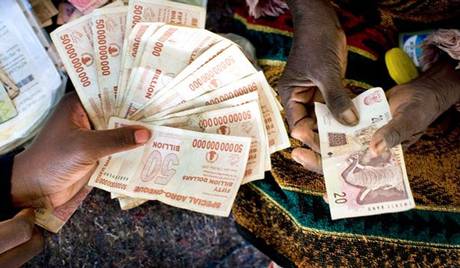Zimbabwe: Zimbabwe finance profile
2012/04/06

Zimbabwe’s disastrous recent political history has taken a heavy toll on the country’s population and economy. Following the chaotic expropriation of white-owned farms since 2000, which left poor land workers jobless and slashed food production, the 2005 clamp-down of the urban opposition movement, which forced 750,000 people into homelessness, and the recent events surrounding the 2008 elections, Zimbabwe is a country in shambles.
Between 2000 and 2007, GDP declined by about 40 %. Unemployment, poverty, malnutrition, and incidence of infectious diseases rose sharply. Today, Zimbabwe has one of the world’s highest HIV/AIDS prevalence rates, affecting one third of the population, and the second lowest life expectancy in the world. At present, a staggering 80 % of the population is unemployed, and 70 % needs food assistance. Social services have collapsed and a cholera epidemic has so far claimed more than 4,000 lives.
The economy is on the brink of collapse. Based on 2008 data, external debt stands at 190 % of GDP ad the current account deficit at 28 % of GDP. Inflation peaked at 500 billion %, fuelled by the Reserve Bank of Zimbabwe’s (RBZ) quasi-fiscal activities, leading to the collapse of the national currency in early 2009: the Zimbabwean dollar has virtually disappeared from circulation, replaced by the US dollar and South African Rand.
The country’s financial sector reflects Zimbabwe’s economic and political distress. The elements of a developed financial system are in place, but activity has shrunk considerably.
As of 2009, the banking sector consisted of 28 institutions, including fifteen commercial banks, six merchant banks, four building societies and three discount houses. The sector is concentrated, and the five largest banks accounting for 65 % of total deposits as of 2004; foreign ownership of private banks stands at 35 %. All major banks have shifted their assets from loans to short-term government securities, with further reductions in financing for the real economy and high costs for the small number of creditworthy customers; they reported high capital adequacy ratios, at an average of 33 %, and little foreign exchange or credit risk.
Political and economic circumstances have negatively impacted the Zimbabwean microfinance industry: as of 2008, 75 microfinance institutions (MFIs) were 75 operating in the country, a 60 % decrease compared to the previous year. Capital and viability concerns plague the sectors: the government has introduced a minimum capital requirement for MFIs, requiring all lending institutions to hold a minimum of USD 5,000, thus leading to small institutions leaving the markets; further, hyperinflation and an unfavourable business environment lead to high interest rates, which in turn ward off potential borrowers and increased default rates.
The government issues treasury bills and bonds with maturities of up to three years. The over-the-counter secondary market for government securities is active, but trading is exclusively carried out by banks.
The Zimbabwe Stock Exchange (ZSE) is active, with about a dozen members, over 65 listed securities and two indices. The ZSE is an active member of the South African Development Cooperation Stock Exchange Committee. Listed companies cannot be more than 40 % foreign-owned, and no single overseas shareholder can possess more than 10 % of corporate shares. Up until 2008, the ZSE was outperforming exchanges in the South African region; it was effectively the sole place in the market where local assets had been able to provide returns ahead of inflation. In November 2008, the ZSE was closed after the RBZ accused traders of using fraudulent checks. When it reopened in February 2009, trades were conducted exclusively in US dollars.

- Zimbabwe News
-
- ZIMBABWE: Tourism Zimbabwe's Eastern Highlands: Africa's latest adventure destination
- ZAMBIA: Zimbabwean farmer digs out weeds from a maize crop.
- BOTSWANA: Routes Africa forum aims to improve African air connectivity
- BOTSWANA: Economic integration is helping boost trade and investment in Africa
- BOTSWANA: Africa’s economic growth is likely to be slower in the intervening years
- BOTSWANA: Beyond Commodities: How African Multinationals Are Transforming
- Trending Articles
-
- CHINA: United States sees China investment talks ‘productive’ after new offers
- SERBIA: China’s Xi sees Serbia as milestone on new ‘Silk Road’
- AUSTRALIA: Australia taxes foreign home buyers as affordability bites
- INDIA: Indian central bank chief to step down in surprise move
- THAILAND: Foreign investment plummets in junta ruled Thailand
- SOUTH AFRICA: South Africa to extend ICT reach








